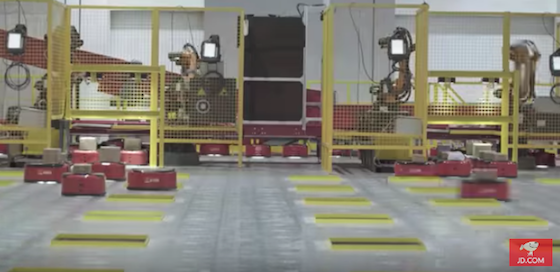China says it has the world’s first totally robotic warehouse although the machines are made in Japan. What’s noticeable about the ‘bots is how much the little floor scooters look like knockoffs from Amazon’s Kiva machines. Often when a large company purchases a smaller one (Amazon buying Kiva for $775 million in 2012), it then leases out that property, but the Bezos company has held its robots close, so there has been scramble for similar machines to be produced. And technology companies have responded with various machines to meet the perceived need.
The warehouse robots of JD.com in Red China look similar to Amazon machines.

Warehouse jobs used to be a possibility for low-skilled persons, but that occupation is one of many that are being disappeared by automation. That trend bodes poorly for the future of human employment.
And given that most immigrants and aliens coming to the US are low-skilled, we shouldn’t continue to admit them like they’re going to be employable in a decade or so. They won’t.
Oxford researchers forecast in 2013 that nearly half of American jobs were vulnerable to machine or software replacement within 20 years. Rice University computer scientist Moshe Vardi believes that in 30 years humans will become largely obsolete, and world joblessness will reach 50 percent. The Gartner tech advising company believes that one-third of jobs will be done by machines by 2025. The consultancy firm PwC published a report last year that forecast robots could take 38 percent of US jobs by 2030. Last November the McKinsey Global Institute reported that automation “could displace up to 800 million workers — 30 percent of the global workforce — by 2030.” Forrester Research estimates that robots and artificial intelligence could eliminate nearly 25 million jobs in the United States over the next decade, but it should create nearly 15 million positions, resulting in a loss of 10 million US jobs.
But wait, is “humanless” really a word now that the age of robots is upon us?
The world’s first humanless warehouse is run only by robots and is a model for the future, CNBC, October 30, 2018
• Mujin, a start-up spun out of Tokyo University, has developed robot controllers that can fully automate warehouses and fulfillment centers.
• Its customer, JD.com, has what it calls the world’s first fully automated e-commerce warehouse in China equipped with Mujin robots.
• The Japanese start-up wants to help automate warehouses in the United States.At a recent technology show in Tokyo, a large robot arm reached into a full-sized mockup of a shipping container and began unloading boxes from it. Set on a platform that moved back and forth, the robot was doing a job usually carried out by warehouse workers and forklift operators. The goal of the company that’s developing it, Mujin, is total automation.
The system, still a prototype, doesn’t work perfectly — it accidentally damaged a box during the demo — but it’s going to be trialed in warehouses in Japan this year.
“Lifting heavy boxes is probably the most backbreaking task in warehouse logistics,” said Mujin’s American co-founder and CTO, Rosen Diankov. “A lot of companies are looking for truck unloading systems, and I believe we’re the closest to commercialization.”
The Tokyo-based start-up is aiming to be a leader in automating logistics processes. To do that, it’s building robot controllers and camera systems and integrating them with existing industrial robot arms. The key product here is the controllers — each about the size of a briefcase, one for motion planning and one for vision — that act as an operating system that can control the hardware from any robot manufacturer. If a goal such as grasping an object is input, the controllers automatically can generate motions for robots, eliminating the traditional need to “teach” robots manually. The result, according to the company, is higher productivity for users.
Simply put, the technology — based on motion planning and computer vision — makes industrial robots capable of autonomous and intelligent action.
Mujin turned heads when it showed off its transformation of a warehouse operated by Chinese e-commerce giant JD.com. The 40,000-sq-m facility in Shanghai began full operations in June. It was equipped with 20 industrial robots that pick, transfer and pack packages using crates on conveyor belts, as well as camera systems and Mujin robot controllers. Other robots carted merchandise around to loading docks and trucks.
Will robots take our jobs? from CNBC.
(Continues)


